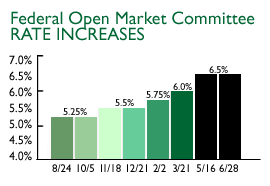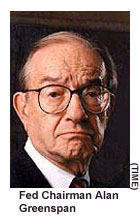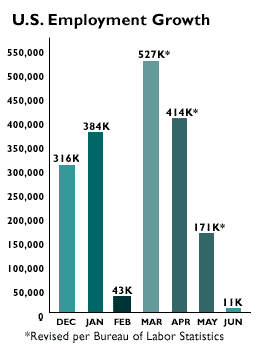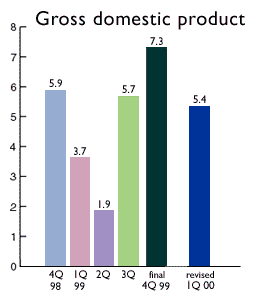|
Greenspan in the House
|
 |
July 25, 2000: 11:54 a.m. ET
Productivity crucial to balanced growth, low inflation Fed chief tells Congress
By Staff Writer M. Corey Goldman
|
NEW YORK (CNNfn) - Strides in productivity have helped propel the U.S. economy to its longest expansion on record, and it is crucial to ensure that those advances continue to keep the economy growing at a sustained, non-inflationary pace, Federal Reserve Chairman Alan Greenspan said Tuesday.
 In a question-and-answer session following testimony on the current state of the economy to the House Banking Committee, Greenspan said that keeping the supply of goods and services on the same level as Americans demand for them is critical to keeping inflation, contained. In a question-and-answer session following testimony on the current state of the economy to the House Banking Committee, Greenspan said that keeping the supply of goods and services on the same level as Americans demand for them is critical to keeping inflation, contained.
All the same, Greenspan warned that keeping that balance up involves continued strides in productivity among American workers -- ensuring that companies use new forms of technology such as computers and the Internet and get the most out of their workers without paying higher wage costs.
"The problem that exists here is that unless we can close the gap between supply and demand by accelerating productivity, which we are doing in part, then the prosperity that everyone is experiencing would be put in great jeopardy," Greenspan told committee members.
The final stretch
The Fed chief's remarks came in the wake of the final leg of his semiannual monetary policy report to Congress, which stuck to the script read last Thursday to the Senate Banking Committee of an encouraging -- but still tentative -- slowdown in the economy. The Q&A that followed his testimony was longer than last Thursday because the House Banking Committee has more members with more questions.
 While Greenspan gave an optimistic assessment of the much-awaited U.S. slowdown, he signaled that it was too early to say whether the economy had cooled sufficiently to cut the risk of overheating and prevent further increases in borrowing costs. While Greenspan gave an optimistic assessment of the much-awaited U.S. slowdown, he signaled that it was too early to say whether the economy had cooled sufficiently to cut the risk of overheating and prevent further increases in borrowing costs.
"It is much too soon to conclude that these concerns are behind us," Greenspan said in his identical prepared remarks, leaving it open about whether the Fed would call it quits after a year-long campaign of six rate increases that have brought the fed funds overnight bank lending rate to 6.5 percent -- its highest level in almost a decade.
The chairman also took the opportunity to voice a not-so-subtle reminder that the Fed does not specifically target stock prices when it makes decisions about whether or not to alter official short-term interest rates. Rather, it takes into account the effect that stock values may have on corporate and consumer spending, and how that will affect the pace of the economy.
Not targeting stocks
"Let me say this anyway on the record: We do not and have not been targeting stock prices for the purposes of endeavoring to stabilize this economy," Greenspan said. "We react if and when stock market price changes impact on the economy. We respond to the economy."
 Financial markets registered little reaction to Greenspan's remarks Tuesday, with both stocks and bonds moderately higher in early afternoon trading following the conclusion of his comments. Greenspan's appearance Tuesday is part of the Fed's long-standing tradition of providing semiannual monetary policy reports to lawmakers, dating back to the 1978 Humphrey-Hawkins Act that made it accountable to Congress. Financial markets registered little reaction to Greenspan's remarks Tuesday, with both stocks and bonds moderately higher in early afternoon trading following the conclusion of his comments. Greenspan's appearance Tuesday is part of the Fed's long-standing tradition of providing semiannual monetary policy reports to lawmakers, dating back to the 1978 Humphrey-Hawkins Act that made it accountable to Congress.
The legal requirement for a monetary report twice a year contained in that act expired earlier this year, but lawmakers are trying to renew it. While that bill is pending, lawmakers and the Fed agreed to carry on the tradition this month. "It is incumbent that we appear before the Congress at fixed times in a year to explain (our policy) in as best detail (as possible)," Greenspan said.
The Nasdaq composite index, which has received much of the attention due to its record 89 percent rise last year and its precipitous 37 percent drop in April and May, is down about 2 percent from the start of the year. It is 26 percent above its May 23 low of 3,164.
Tight labor markets
Greenspan also addressed the country's labor market, pointing out that, in his opinion, the U.S. employment situation is not yet at a point where it threatens to spark a massive increase in wage inflation.
 "It is possible to get markets which are too tight, which create inflationary imbalances and ultimately undercut the recovery," Greenspan said. "There are those in the economics profession who believe we have already gone beyond the point at which we are creating instabilities; I personally don't believe that," he said. "It is possible to get markets which are too tight, which create inflationary imbalances and ultimately undercut the recovery," Greenspan said. "There are those in the economics profession who believe we have already gone beyond the point at which we are creating instabilities; I personally don't believe that," he said.
The U.S. economy generated 11,000 new jobs last month, according to figures compiled by the Labor Department, while wages rose modestly.
Greenspan also addressed Tuesday's economic reports showing an upswing in consumer confidence and home sales, suggesting that the consumer confidence numbers in particular were useful for the Fed in its rate decisions.
At the same time, he noted that additional government data due to be released in the next several weeks -- reports on second-quarter wage costs, second-quarter growth and July unemployment, among others, will provide key information for policymakers before their next meeting on Aug. 22.
"There's an awful lot of information" coming out that "clearly will have an impact" on the Fed's decision, Greenspan said.
No choice on rate hikes
As for the Fed's other rate hikes, Greenspan told the House panel that policy makers had no choice but to move swiftly to combat what appeared to be accelerating inflation back in June 1999.
 "Had we endeavored a year ago June to keep the federal funds rate where it was at that time...that could only have been done by suppressing the markets by creating a massive amount of liquidity, which would invariably have financed a significant acceleration in inflation and brought this recovery to a very quick end," he said. "Had we endeavored a year ago June to keep the federal funds rate where it was at that time...that could only have been done by suppressing the markets by creating a massive amount of liquidity, which would invariably have financed a significant acceleration in inflation and brought this recovery to a very quick end," he said.
Even after most of those rate increases had been implemented, including the Fed's wrenching half-point hike in May, the economy was still exhibiting signs of imbalances, particularly at the end of the first quarter, Greenspan said. The U.S. economy expanded at a 5.4 percent pace in the first three months of the year, down from a 7.3 percent pace in the fourth quarter.
"The data that we have for the first quarter still suggests as of then it was out of balance," he said. At the same time, "we seem to be moving closer to balance in the last two or three months but we do not as yet have adequate data to suggest how much closure has occurred and will not have for a while." 
|
|
|
|
|
|
U.S. Federal Reserve
|
Note: Pages will open in a new browser window
External sites are not endorsed by CNNmoney
|
|
|
|
 |

|

